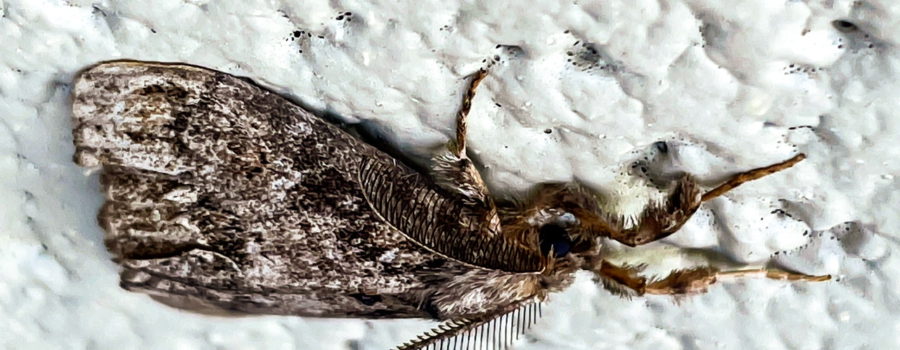The Interesting White-Marked Tussock Moth is a Surprisingly Late Survivor

Now that even in Florida we are seeing cooler weather (we had our first frost in my area early last week) many of our abundant insects are in their dormant stages, so we are seeing fewer of them out and about. Even the mosquitoes that were everywhere during our late summer rains have more or less gone away. That’s why I was actually surprised to see a white-marked tussock moth (Orgyia leucostigma) on the wall of our kennels a couple of weeks ago. I’m sure it was one of the few survivors by that point, and the frost probably got it if it hadn’t died already. I suspect that a lot of the nocturnal insects see our white walls as a light source, because it’s always been a good place to look for insects in the early morning.

Even though this adult moth was nothing super exceptional to look at, I was still intrigued by it’s big, feather-like antennas and it’s furry legs and feet. The antennas are especially cool as you can see by the photos. Even though we generally think of antennas as hearing organs, in these moths they are smelling organs. Female white-marked tussock moths have very rudimentary wings (if any at all) and are flightless. In fact, they usually stay on the tree where they pupate and don’t even roam far from their old cocoon. When they are ready to mate they produce pheromones that attract the males. The male uses his large, ornate antennas to detect those pheromones so that he can find receptive females. After mating, the female will lay a mass of eggs in a protective froth over her old cocoon. Soon after she does that, she dies. Because the females are shorter lived and don’t fly most of the adult moths that we see, including this one, are males. In most climates these moths will produce two generations per year, but in some of the warmer areas where they live, they can produce three generations.

The white-marked tussock moths are closely related to the fir tussock moths (Orgyia pseudotsugata), and like them, they produce a colorful, fuzzy caterpillar with spiky hairs that can cause an uncomfortable rash if touched. While fir tussock moths strongly prefer to feed on Douglas fir trees, white-marked tussock moths will feed on over 140 species of evergreen and deciduous trees. A few of the types that they like include oaks, pines, pecans, apples, firs, hemlock, roses, and willows. Being generalist feeders means that these moths can be found throughout a pretty extensive range including all of the eastern United States and Canada as well as Mexico, Central America, and into northern South America. They tend to be solitary moths except at breeding time, and when the eggs first hatch. The first larval stage of these moths eats mostly the pulpy matter from the new growth leaves. They tend not to eat the veins, so they will give young leaves a skeletonized appearance. As these caterpillars grow, they start to eat older leaves, too, and they will eat the finer veins, leaving only the largest veins. If there are enough caterpillars on a single tree or in a single stand of trees, they can do significant damage, sometimes even killing saplings or older trees. Fortunately, this doesn’t happen often since these caterpillars have plenty of diseases and predators that tend to keep them in check.

Only time will tell for sure, but I suspect that I’ve seen my last tussock moth for a little while. I’m still seeing some of the smaller moths that live in the leaf litter and other areas that are sheltered from the cold, but any tree dwelling moths are probably done for this year. But winter and colder weather are pretty short lived around here, so it won’t be long before things are hatching out again. I’m looking forward to trying to find more of the tussock moth caterpillars again this spring. If I can find a tree with quite a few of them I’d like to be able to document their growth and eventually find some females. We’ll see what happens.
If you love beautiful nature photography and artwork accompanied by informative and entertaining nature and animal related content, then this blog is for you. Subscribe today! It’s fun and it’s free!





Recent Comments